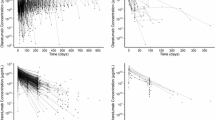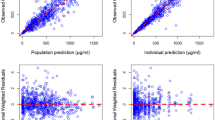Abstract
Purpose
Volociximab is a chimeric IgG4 that is being developed as a novel first-in-class anti-angiogenic, α5β1 integrin inhibitor for the treatment of solid tumors. A mechanism-based pharmacokinetic (PK)/pharmacodynamic (PD) model was developed to investigate the dynamic interaction between volociximab concentrations and free monocyte α5β1 integrin levels in cancer patients.
Methods
Twenty-one cancer patients from six dose cohorts (0.5, 1.0, 2.5, 5.0, 10, and 15 mg/kg) were included in the analysis. The fully integrated receptor-binding PK/PD model was developed and fit simultaneously to the PK/PD data. A Monte-Carlo parametric expectation-maximization method implement in S-ADAPT program was used to obtain estimates of population parameters and inter- and intra-subject variability.
Results
The PK/PD time profiles were well described by the model and the parameters were estimated with good precision. The model was used to simulate PK/PD time profiles for multiple dose regimens at various dose levels, and the results suggested that the monocyte α5β1 integrin binding was saturated (≤5% free) at week 16 in the majority of patients treated with volociximab doses ≥10 mg/kg IV every 2 weeks.
Conclusions
The developed model is useful for anticipating the drug exposures and extent of volociximab binding to peripheral monocyte α5β1 integrin in untested regimens and for optimizing the design of future clinical trials.






Similar content being viewed by others
References
Bauer RJ, Guzy S (2004) Monte Carlo parametric expectation maximization (MC-PEM) method for analyzing population pharmacokinetic/pharmacodynamic (PK/PD) data. In: D’Argenio DZ (ed) Advanced methods of pharmacokinetic and pharmacodynamic system analysis. Kluwer, Boston, pp 135–163
Beal SL (2001) Ways to fit a PK model with some data below the quantification limit. J Pharmacokinet Pharmacodyn 28:481–504
Breier G, Risau W (1996) The role of vascular endothelial growth factor in blood vessel formation. Trends Cell Biol 6:454–456
Brooks PC, Clark RA, Cheresh DA (1994) Requirement of vascular integrin alpha v beta 3 for angiogenesis. Science 264:569–571
Brooks PC, Montgomery AM, Rosenfeld M, Reisfeld RA, Hu T, Klier G, Cheresh DA (1994) Integrin alpha v beta 3 antagonists promote tumor regression by inducing apoptosis of angiogenic blood vessels. Cell 79:1157–1164
Cranmer LD, Bedikian AY, Ribas A, O’Day S, Forero-Torres A, Yazji S, Kirkwood M (2006) Phase II study of volociximab (M200), an alpha-5 beta-1 anti-integrin antibody in metastatic melanoma. J Clin Oncol 24:8011
D’ Argenio D, Schumitzky A (1997) ADAPT II user’s guide: pharmacokinetic/pharmacodynamic system analysis software. Biomedical Simulations Resources, Los Angeles
Davies B, Morris T (1993) Physiological parameters in laboratory animals and humans. Pharm Res 10:1093–1095
Evans T, Ramanathan RK, Yazji S, Glynne-Jones R, Anthoney A, Berlin J, Valle JW (2007) Final results from cohort 1 of a phase II study of volociximab, an anti-alpha5 beta1 integrin antibody, in combination with gemcitabine (GEM) in patients (pts) with metastatic pancreatic cancer (MPC). J Clin Oncol 25:4549
Ferrara N, Gerber HP, LeCouter J (2003) The biology of VEGF and its receptors. Nat Med 9:669–676
Folkman J (1995) Angiogenesis in cancer, vascular, rheumatoid and other disease. Nat Med 1:27–31
Folkman J (2002) Role of angiogenesis in tumor growth and metastasis. Semin Oncol 29:15–18
Francis SE, Goh KL, Hodivala-Dilke K, Bader BL, Stark M, Davidson D, Hynes RO (2002) Central roles of alpha5 beta1 integrin and fibronectin in vascular development in mouse embryos and embryoid bodies. Arterioscler Thromb Vasc Biol 22:927–933
Friberg LE, Henningsson A, Maas H, Nguyen L, Karlsson MO (2002) Model of chemotherapy-induced myelosuppression with parameter consistency across drugs. J Clin Oncol 20:4713–4721
George EL, Georges-Labouesse EN, Patel-King RS, Rayburn H, Hynes RO (1993) Defects in mesoderm, neural tube and vascular development in mouse embryos lacking fibronectin. Development 119:1079–1091
Hwang R, Varner J (2004) The role of integrins in tumor angiogenesis. Hematol Oncol Clin North Am 18:991–1006, vii
Kim S, Bakre M, Yin H, Varner JA (2002) Inhibition of endothelial cell survival and angiogenesis by protein kinase A. J Clin Invest 110:933–941
Kim S, Harris M, Varner JA (2000) Regulation of integrin alpha vbeta 3-mediated endothelial cell migration and angiogenesis by integrin alpha5beta1 and protein kinase A. J Biol Chem 275:33920–33928
Mager DE (2006) Target-mediated drug disposition and dynamics. Biochem Pharmacol 72:1–10
Ng CM, Joshi A, Dedrick RL, Garovoy MR, Bauer RJ (2005) Pharmacokinetic-pharmacodynamic-efficacy analysis of efalizumab in patients with moderate to severe psoriasis. Pharm Res 22:1088–1100
Ng CM, Stefanich E, Anand BS, Fielder PJ, Vaickus L (2006) Pharmacokinetics/pharmacodynamics of nondepleting anti-CD4 monoclonal antibody (TRX1) in healthy human volunteers. Pharm Res 23:95–103
Ramakrishnan V, Bhaskar V, Law DA, Wong MH, DuBridge RB, Breinberg D, O’Hara C, Powers DB, Liu G, Grove J, Hevezi P, Cass KM, Watson S, Evangelista F, Powers RA, Finck B, Wills M, Caras I, Fang Y, McDonald D, Johnson D, Murray R, Jeffry U (2006) Preclinical evaluation of an anti-alpha5beta1 integrin antibody as a novel anti-angiogenic agent. J Exp Ther Oncol 5:273–286
Ricart AD, Tolcher AW, Liu G, Holen K, Schwartz G, Albertini M, Weiss G, Yazji S, Ng C, Wilding G (2008) Volociximab, a chimeric monoclonal antibody that specifically binds alpha5beta1 integrin: a phase I, pharmacokinetic, and biological correlative study. Clin Cancer Res 14:7924–7929
Risau W (1997) Mechanisms of angiogenesis. Nature 386:671–674
Waldmann TA, Strober W (1969) Metabolism of immunoglobulins. Prog Allergy 13:1–110
Witmer AN, Vrensen GF, Van Noorden CJ, Schlingemann RO (2003) Vascular endothelial growth factors and angiogenesis in eye disease. Prog Retin Eye Res 22:1–29
Yazji S, Bukowski R, Kondagunta V, Figlin R (2007) Final results from phase II study of volociximab, an alpha-5 beta-1 anti-integrin antibody, in refractory or relapsed metastatic clear cell renal cell carcinoma (mCCRCC). J Clin Oncol 25:5094
Author information
Authors and Affiliations
Corresponding author
Rights and permissions
About this article
Cite this article
Ng, C.M., Bai, S., Takimoto, C.H. et al. Mechanism-based receptor-binding model to describe the pharmacokinetic and pharmacodynamic of an anti-α5β1 integrin monoclonal antibody (volociximab) in cancer patients. Cancer Chemother Pharmacol 65, 207–217 (2010). https://doi.org/10.1007/s00280-009-1023-8
Received:
Accepted:
Published:
Issue Date:
DOI: https://doi.org/10.1007/s00280-009-1023-8




